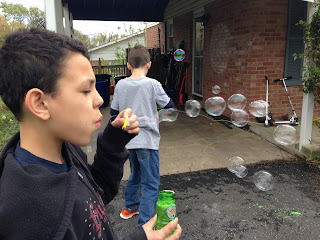This series is focused on the forces that shape and change our planet. I'm using it for 8-12 year olds, but I've done it with kids as young as 5-6.
Our planet is always undergoing changes, but when big changes happen quickly, we call them disasters: hurricanes, volcanoes, earthquakes, and the like.
One big force driving changes on our planet is the sun!
Yes, I realize there is a more accurate song, but I find that with young kids, it's better to use this song, and then explain that the gas on the sun is so hot that it's actually a new form of matter called plasma (because it's electrons are stripped away).
Understanding exactly how the sun is affecting the earth is one od those things where a demonstration is worth 1000 lectures.
I like to take the globe into a dark place and use an incandescent bulb to represent the sun. My globe has a conveniently accurate tilt, so it's easy to walk it around the "sun" and see how the parts of the earth receive more or less light at different points in the earth's orbit.
If you use an incandescent bulb, you can also show how distance and angle affect the heat each part receives (I have them put their hand on the globe).
Now a question: you can see how the sun gives heat and light to the earth, but what effect does that really have? Could that light actually move anything on the earth?
Most kids don't think so, until I show them my radiometer. It was a cloudy day, so I had to take it outside to get it really moving.
The sun is really adding energy and moving things around on our planet!
Next question: what color is the sun?
 We looked with a spectrometer! Mine is store bought, but they are easy to make. You can see all the colors the sun is giving off!
We looked with a spectrometer! Mine is store bought, but they are easy to make. You can see all the colors the sun is giving off!We also looked at the light through prisms and water filled jars.
The jars help you see how light is bent and scattered as it passes through the atmosphere. Air molecules scatter more blue light (which is why the sky is blue). Water and dust tend to scatter the light evenly, so they look white.
This is why when you look straight up, the sky looks a darker blue: you are looking straight through the atmosphere. When you look on the horizon, it usually looks paler because you are looking at the atmosphere at an angle and are seeing more of the low hanging water and dust. Our summers are so humid that the sky looks nearly white at the horizon! You can see a little of this by looking through the jar straight on, and then at an angle.
Next up: wind!
 What makes the wind? One small part is the rotation of the earth. I had the kids spin around with outstretched arms to feel the breeze.
What makes the wind? One small part is the rotation of the earth. I had the kids spin around with outstretched arms to feel the breeze.Most of our wind is from the sun heating the atmosphere.
How much the sun will heat things up depends on many factors, including the color of the earth beneath the air. I used my scanning thermometer to look at the temperature of the black driveway and the light sidewalk: a 10 degree difference!
 As the air warms, it expands, and as it cools, it shrinks. I like to have the kids model this by having them move slowly close together, then faster, bumping off of each other and taking up more space.
As the air warms, it expands, and as it cools, it shrinks. I like to have the kids model this by having them move slowly close together, then faster, bumping off of each other and taking up more space.You can see this by blowing bubbles on a cold day. Bubbles blown with your warm breath will rise, and bubbles made by the breeze from swinging your arms tend to fall. This works best on a cold day without a lot of wind!




No comments:
Post a Comment